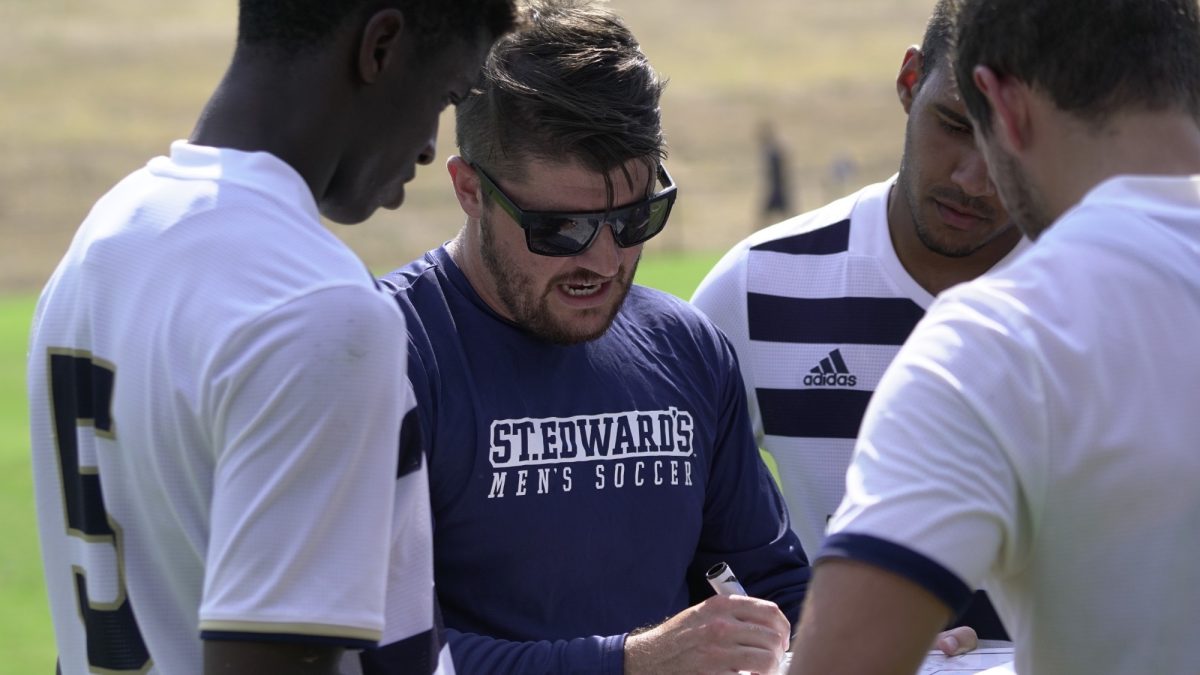John Knorr has been serving the hilltop since the dawn of the ‘70s. From assistant baseball coach to Head Coach to Athletic Director to Professor of Kinesiology — when it comes to athletics, he’s done it all. Now, Professor Knorr is publishing a complete history of St. Edward’s athletics after seven years of rigorous research and diligent diction. His book, “St. Edward’s University Athletics: A History from Saints to Tigers to Hilltoppers,” tells the story from conception to present day.
Knorr was hired on as assistant baseball coach in the spring of 1972. As such, he has been witness to much of the university’s pivotal sports history and has known many of its star coaches and players.
“I know a lot of the really principal characters from the years,” Knorr said. “For example, Ed Norris. I worked for Tom Hamilton, who’s a legend in baseball, (the) baseball field is named after Tom. I was his assistant coach when I first got here. Tom goes back to the early 60s. But the athletic director and the basketball coach, Ed Norris, goes back to 1939 when he first got here as an athlete, and then he became basketball coach, athletic director, Dean of Men, and they had hired me back here as a baseball coach in ‘77. So I knew a lot of these people.”
While Knorr knows a lot about St. Edward’s history of athletics, that isn’t the case for most people on the hilltop. Immortalizing the stories and statistics of the past in a concise history is important to Knorr.
“People think small schools, they kind of downplay (us),” Knorr said. “‘It’s not the University of Texas, what do they have?’ We have a remarkable history. About seven years ago, I had just had another project, a textbook, published. I was looking for something to do. So I thought, institutional memory is an important thing. And if we don’t get it down on paper, if we don’t write it, it gets lost. And so I decided to start this project. So I spent six years of research in the archives and other places, and then about a year to write, edit and get it ready for publication. So it was really the idea that we need to keep institutional memory alive. You really don’t know where you’re going unless you have an appreciation for where you’ve been. And we’ve got a tremendous past in athletics here. It’s incredible.”
Despite Knorr’s 52-year presence on the hilltop, there were still eras that were difficult to write about. Although sports have always been a large part of St. Edward’s culture, there hasn’t always been thorough documentation of it.
“It was interesting because the yearbooks were great at times, but a lot of times you’d open up the yearbook, and they’d have a lot of stuff on there (about) athletics, but they had no cut lines,” Knorr said. “Basketball team: no cut lines about who was there. A guy taking a jump shot at St. Mary’s: no cut line about who it was. And then, unfortunately, the newspaper at St. Edward’s, like probably all newspapers, goes with the era. And so in parts of the ‘70s, late ‘60s and ‘70s, little mention was given to sports because everything was about Vietnam and about student unrest. And the only thing in the sports sections of the newspapers at that time were intramural, there was not much published. And so from that era, I was able to find other documents that were there, they did a little reporting, plus my own memories.”
Writing about his time coaching also came with its own challenges. Knorr was hesitant to give too many details or “overdo it.” However, his personal connection to this time allowed him to write in detailed specificity that he couldn’t necessarily do with every time period, because he had been there to witness the major events. Writing about this era, from the ‘70s to the ‘80s and some of the early ‘90s, brought a flood of nostalgia.
“It brought back a lot of memories,” Knorr said. “And since this has been published and made public about the book, a lot of my ex-athletes have emailed me saying ‘oh, I can’t wait to read it, can’t wait to read about my era.’ When I sent it back to them, I say I hope you enjoy the book and I hope the era brings back memories.”
It wasn’t always pretty — no history is. But Knorr didn’t shy away from any of it; he aimed to tell the truth of it all, as is.
“Here’s what you want to do with a history: you want to write it,” Knorr said. “And we didn’t gloss over it. I mean, we talked about the good and the bad things that happened over the years. We had no athletics at the beginning of World War (II), they just dropped it, (they) couldn’t afford it. And they didn’t bring it back until 1946. And then when they did, they only brought back basketball and baseball, (they) couldn’t bring back football because of the cost. Then we get into the era of women’s athletics in the ‘70s. And how we grew that. But yeah, we talked about the good and the bad in there.”
This historical behemoth took seven long years of research in the SEU archives, extensive notes on his findings, personal testimonies and thousands of hours to create. The collection is so impressive in size that Knorr and the university had to negotiate with the publisher, The History Press, to publish a book twice their standard printing size and with 1.5 times the pictures. The final product is 398 pages long, with over 125 pictures dating back to the earliest days on campus.
A couple of images in particular stood out to Knorr, as they accompanied humorous stories — one of his favorite parts about writing the book. On page 147 you can find an image of baseball players paying homage to their damaged field.
“There’s a couple humorous stories,” Knorr said. “We started building this field down here in ‘63. But, like everything, funds ran dry, problems happened. And we didn’t get the fence built until about ‘67. It’s not complete, but it’s ready to play on so they’re gonna have their first home game that weekend. Okay, everybody’s so excited. In the interim, we get a mini tornado (that) comes through and blows down the wood fence. The seniors (baseball players) went out and they played Taps over the fence that was down in memory. They played Taps over the dead fence. And there’s other humorous stories in there.”
What this book really means to Knorr, though, is the people within it and their dedication to sports on the hilltop.
“It’s really the totality of the whole thing to see, you know, the evolution of athletics, what it meant on campus, the people who gave their whole careers to making it happen at a time we didn’t pay that well,” Knorr said. “Well, you know, coaches did other things besides coach. (We) didn’t have the greatest facilities and yet we were successful. You know, and it really meant something to people.”









